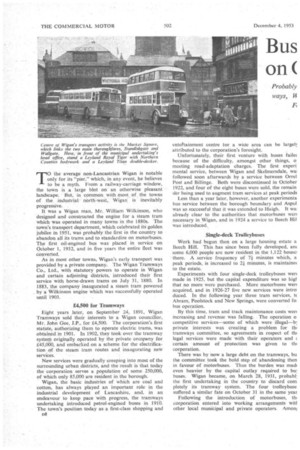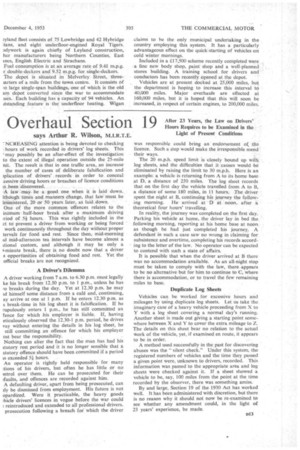Bus n Built on( [Cotton
Page 48

Page 49

Page 50

Page 53

If you've noticed an error in this article please click here to report it so we can fix it.
Probably ways, H
ry to Abandon Tramtinent is Still in the ye Undertaking ,!ombe
TO the average non-Lancastrian Wigan is notable only for its "pier," which, in any event, he believes to be a myth. From a railway-carriage window, the town is a large blot on an otherwise pleasant landscape. But, in common with most of the towns of the .industrial nofth-West, Wigan is inevitably progressive. . It was a Wigan man, Mr. William Wilkinson, who designed and constructed the engine for a steam tram which was operated in many towns in the 1880s. The town's transport department, which celebrated its golden jubilee in 1951, was probably the first in the country to abandon all its trams and to standardize on motorbuses. The first oil-engined bus was placed in service on October 1, 1932, and in five years the entire fleet was Converted. As in most other towns, Wigan's early transport was provided by a private company. The Wigan Tramways Co., Ltd., with statutory powers to operate in Wigan and certain adjoining districts, introduced their first service with horse-drawn trams on July 31, 1880. In 1883, the company inaugurated a steam tram powered by a Wilkinson engine which was successfully operated until 1903.
£4,500 or Tramways Eight years later, on September 24, 1891, Wigan Tramways sold their interests to a Wigan councillor, Mr. John Gee, J.P., for £4,500. The corporation's, first statute, authorizing them to operate electric trams, was obtained in 1901. In 1902, they took over the tramway system originally operated by the private company for £45,000, and embarked on a scheme for the electrification of the steam tram routes and inaugurating new services. New services were gradually creeping into most of the surrounding urban districts, and the result is that today the corporation serves a population of some 250,000, of which only 85,000 are resident in the borough. Wigan, the basic industries of which are coal and cotton, has always played an important role in the industrial development of Lancashire, and, in an endeavour to keep pace with progress, the tramways undertaking introduced petrol-engined buses in 1910. The town's position today as a first-class shopping and D8 entelitainment centre tor a wide area can be largeb attributed to the corporation's foresight. Unfortunately, their first venture with buses faile( because of the difficulty, amongst other things, o meeting road-adaptation charges. The first experi mental service, between Wigan and Skelmersdale, wa! followed soon afterwards by a service between Orrel Post and Billinge. Both were discontinued in October 1922, and four of the eight buses were sold, the remain der being used to augment tram services at peak periods Less than a year later, however, another experimenta bus service between the borough boundary and Aspul was so successful that it was extended to Haigh. It wa: already clear to the authorities that motorbuses wen necessary in Wigan, and in 1924 a service to Beech Hi] was introduced.
Single-de& Trelleybuses Work had begun then on a large housing estate a Beech Hill. This has since been fully developed, an( some 6,000 people are now resident in the 1,122 house! there. A service frequency of 7/ minutes which, a peak periods, is increased to 2/ minutes, is maintaine( to the estate. Experiments with four single-deck trolleybuses wen made in 1925, but the capital expenditure was so hie that no more were purchased. More motorbuses wen acquired, and in 1926-27 five new services were intro duced. In the following year three tram services, t( Abram, Poolstock and New Springs, were converted fo bus operation. By this time, tram and track maintenance costs wen increasing and revenue was falling. The operation o competitive services—some of which were illegal—b] private interests was creating a problem for till tramways committee, so agreements in respect of thi legal services were made with their operators and E certain amount of protection was given to thi corporation. There was by now a large debt on the tramways, bu the committee took the bold step of abandoning then in favour of motorbuses. Thus the burden was madi even heavier by the capital outlay required to bu: buses. Wigan became, on March 28, 1931, probabl: the first undertaking in the country to discard corn pletely its tramway system. The four trolleybuse suffered a similar fate on October 31 in the same year Following the introduction of motorbuses, till corporation entered into working arrangements Witl other local municipal and private operators. Amoni these were the transport departments of Bolton, St. Helens, Salford and Leigh, and Ribble Motor Services, Ltd., and Lancashire United Transport, Ltd. Joint services from Wigan to Bolton, Liverpool. Manchester, St. Helens and Wrightington were then introduced.
In 1935, Wigan joined with Ribble and St. Helens Corporation in the purchase of Messrs. Cadman's services, which were operating from Billinge and Offal via Kitt Green to Wigan. Wigan took over the Kitt Green service and worked it independently, at the same time joining with the other two operators in maintaining the services from Wigan to St. Helens and from Wigan to Rainford.
Within four years, the services of two more private operators were acquired jointly with Ribble. The purchase of the Wigan-Appley Bridge service of H. Tennant and Co., which was taken over in 1938 and has since been considerably developed, was followed shortly afterwards by, the acquisition of the WiganAdlirtgton service of the Yarrow Motor Co.
'Debt Liquidated By 1937, after six years of motorbus operation, the undertaking had liqtridated the outstanding debt which, in 1931, stood at £167,046, contributed £81,589 towards loan charges and the purchase of new vehicles, paid £5,000 towards the cost of road reinstatement, replaced petrol by oil engines at a cost of £17,792, and recommended reductions in fares, which were introduced on April 1, 1937.
Those fares were applied until 1951, when increases realizing some £75,000 a year were introduced. Since then there has been another increase—in September, 1952, when id. was added to all fares over 21d. This is estimated to bring in another £62,000 a year.
Heading the department today is Mr. J. McKnight, A.M.Inst.T., who has been with the undertaking since he was a boy. Consistency seems to be the keynote at Wigan, for the chairman of the transport committee, Aid. E. Ball, J.P., has held the position for 24 years.
Although there has been a gradual change in the industrial structure of the area in the past 15 years, coal and cotton having been displaced to a certain extent by a variety of new industries, such as food canning and asbestos processing, Wigan's continued dependence on cotton was emphasized by last year's slump in the industry. The first effect was favourable to the transport department, in that it provided a partial solution to the staff-shortage problem, but had the slump continued the undertaking would have suffered a serious loss of revenue.
Peak at 4 2.111.
Although coal may not today play the important part that it has in the town's past, Wigan remains at the heart of the extensive coalfields of Lancashire, and many of its male inhabitants are still engaged in the industry. Many of these miners travel to Leigh, seven miles away, and to Tyldesley, Astley and Mosley Common, near Manchester. As most of them live in Wigan's outlying districts, they have to be brought into the town to transfer. to special services operated jointly with Lancashire United. Thus, Wigan's morning peak can be said to begin as early as 4 a.m.
Similar arrangements, although to a lesser extent, exist for cotton workers, many of whom are .employed at mills in Leigh and Bolton.
Because of the town's position as a mining centre, its transport department maintains an all-night emergency DIO service in the event of accidents at any of the collier in the area. At shOrt notice; transport for up to 7' people can be arranged to and from the scene of a such disaster. Happily, the service is rarely brought ir action.
With its numerous cinemas, theatres and dance-ha. Wigan has long been a popular entertainment centre a wide area, but in the past 18 months there has be a noticeable decline in pleasure traffic.
The centre of the town's . transport activities—ar incidentally, of the town—is the department's he office in the Market Place, Which forms a link betwe the two main thoroughfares, Standishgate and Wallga Within a radius of 300 yd. of this congested point sta the central bus stops from where. the local servic operate. Because of congestion, most of the servic have their termini at points away from the town cent their routes taking them through the town.
At the present time, the department has no b station, but the council recently approved a plan for small temporary station which is to be built at ti junction of Standishgate and Crompton Street, son 500 yd. from the Market Place. A corporation-own. bus station on the market square is used almost excl sively by private operators—many of whom have joi interests with the transport department—for merlin and long-distance services.
Twenty-seven ordinary and nine workers' services a operated solely by the department. Joint services wi both private and other municipal operators number 1 nine ofwhich are exclusive to workers. Route milea; is 158.44.
Although working during the first three months the current financial year has shown a profit, the depai ment lost £6,620 in 1952-3. That, however, was improvement on the previous year's loss of £7,891.
Mileage, at 5,064,007 in 1952-53, showed a decrea of 9,500 on the previous year's figure and, similarly, ti number of passengers carried was down from 61,425,4. to 61,062,864.
The bulk of the department's fleet of 162 vehicles .of post-war manufacture. All, except three Brist double-deckers with A.E.C. engines, are Leylands, 31 which are pre-war Lowbridge Titans and three a vertical-engined Tiger single-deckers. The post-w 2.yland fleet consists of 75 Lowbridge and 42 Hybridge [tans, and eight underfloor-engined Royal Tigers. adywork is again chiefly of Leyland construction, her manufacturers being Northern Counties, East incs, English Electric and Strachans.
Fuel consumption is at an average rate of 9.41 m.p.g. T double-deckers and 9.52 m.p.g. for single-deckers. The depot is situated in Melverley Street, threeiarters of a mile from thetown centre. It consists of /6 large single-span buildings; one of which is the old am 'depot Converted since the war to accommodate ises. Each building has a capacity of 94 vehicles. An itstanding feature: is the Underfloor heating. Wigan claims to be the only municipal undertaking in the country employing this system. It has a particularly advantageous effect on the quick-starting of vehicles on cold winter mornings. Included in a £17,500 scheme recently completed were . a fine new body shop, paint shop and a well-planned • stores building. A training school for drivers and conductors has been recently opened at the depot.
Vehicles are at present docked at 25,000 miles, but the department is hoping to increase this interval to 40,000 miles. Major overhauls are effected at 160,000 miles, but it is hoped that this will soon be increased, in respect of certain engines, to 200,000 miles,
































































































